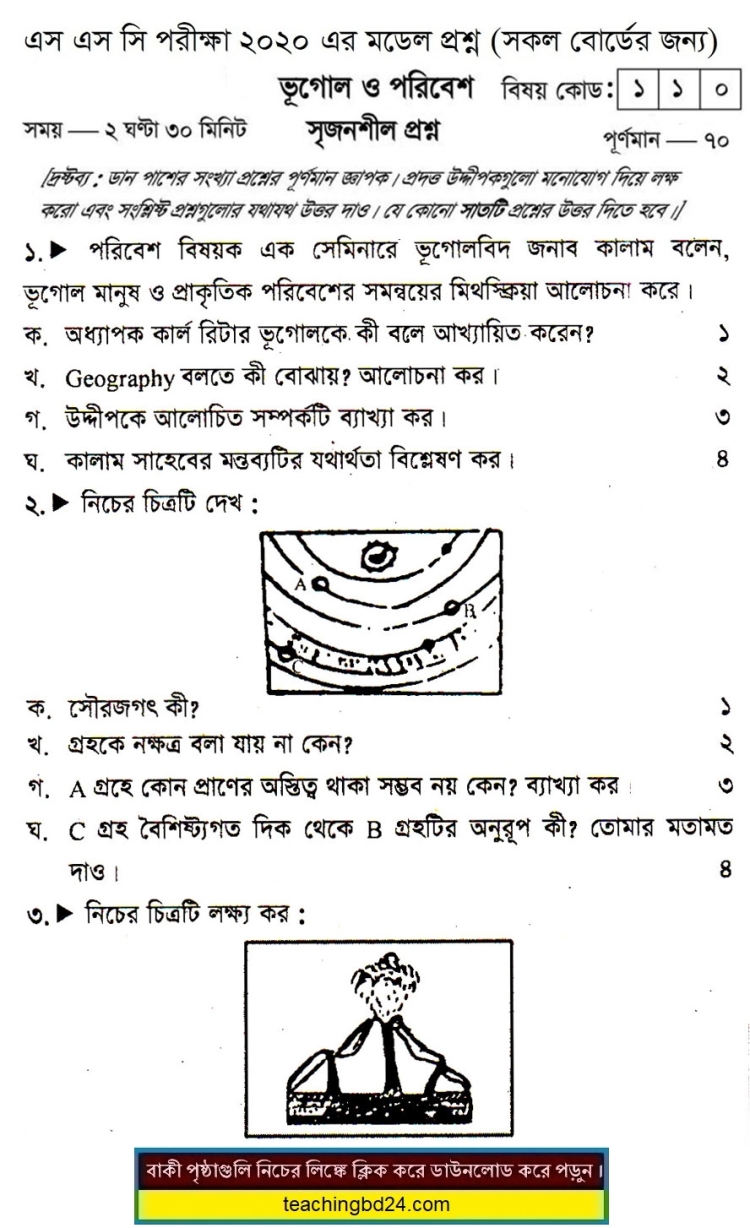SSC Geography and Environment Suggestion Question 2020-2. Geography is the science that studies the lands, the features, the inhabitants, and the phenomena of the Earth. A literal translation would be “to describe or write about the Earth”. The first person to use the word “geography” was Eratosthenes (276-194 BC). Four historical traditions in geographical research are the spatial analysis of the natural and the human phenomena (geography as the study of distribution), the area studies (places and regions), the study of the man-land relationship, and the research in the earth sciences.
Nonetheless, modern geography is an all-encompassing discipline that foremost seeks to understand the Earth and all of its human and natural complexities – not merely where objects are, but how they have changed and come to be. Geography has been called “the world discipline” and “the bridge between the human and the physical science”. Geography is divided into two main branches: human geography and physical geography.
SSC Geography and Environment Suggestion Question 2020-2

Model Question No. 2

Traditionally, geographers have been viewed the same way as cartographers and people who study place names and numbers. Although many geographers are trained in toponymy and cartology, this is not their main preoccupation. Geographers study the spatial and temporal distribution of phenomena, processes, and features as well as the interaction between humans and their environment. Because space and place affect a variety of topics, such as economics, health, climate, plants, and animals; geography is highly interdisciplinary.
The environment is everything that is around us. It can be living or non-living things. It includes physical, chemical and other natural forces. Living things live in their environment. They constantly interact with it and adapt themselves to conditions in their environment.
The natural environment encompasses all living and non-living things occurring naturally, meaning in this case not artificial. The term is most often applied to the Earth or some parts of Earth. This environment encompasses the interaction of all living species, climate, weather and natural resources that affect human survival and economic activity. The concept of the natural environment can be distinguished as components:
Complete ecological units that function as natural systems without massive civilized human intervention, including all vegetation, microorganisms, soil, rocks, atmosphere, and natural phenomena that occur within their boundaries and their nature.
Universal natural resources and physical phenomena that lack clear-cut boundaries, such as air, water, and climate, as well as energy, radiation, electric charge, and magnetism, not originating from civilized human actions.
In contrast to the natural environment is the built environment. In such areas where man has fundamentally transformed landscapes such as urban settings and agricultural land conversion, the natural environment is greatly modified into a simplified human environment. Even acts which seem less extreme, such as building a mud hut or a photovoltaic system in the desert, the modified environment becomes an artificial one.
Though many animals build things to provide a better environment for themselves, they are not human, hence beaver dams and the works of Mound-building termites are thought of as natural.
People seldom find absolutely natural environments on Earth, and naturalness usually varies in a continuum, from 100% natural in one extreme to 0% natural in the other. More precisely, we can consider the different aspects or components of an environment, and see that their degree of naturalness is not uniform.[2] If, for instance, in an agricultural field, the mineralogic composition and the structure of its soil are similar to those of undisturbed forest soil, but the structure is quite different.
teachingbd24.com is such a website where you will get all kinds of necessary information regarding educational notes, suggestions and question patterns of schools, colleges, and madrasas. Particularly, you will get here special notes of physics that will be immensely useful to both students and teachers. The builder of the website is Mr. Md. Shah Jamal who has been serving for 33 years as an Assistant Professor of Physics at BAF Shaheen College Dhaka. He expects that this website will meet up all the needs of Bengali version learners /students. He has requested concerned students and teachers to spread this website home and abroad.
Discover more from Teaching BD
Subscribe to get the latest posts sent to your email.


